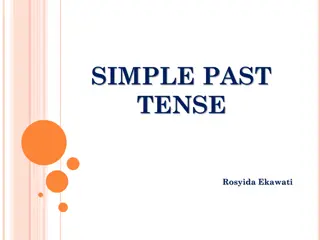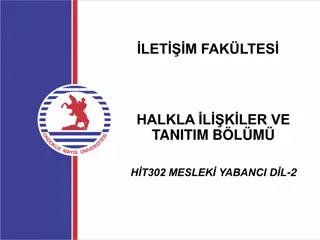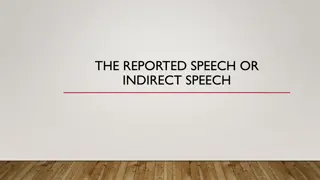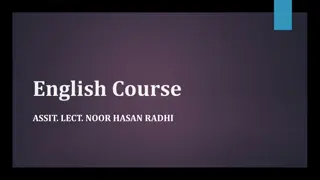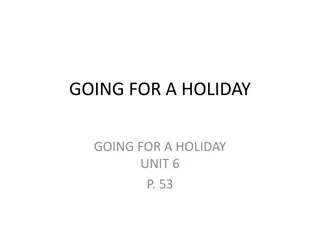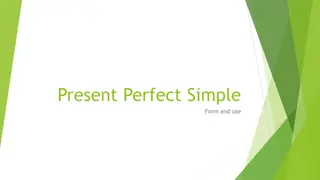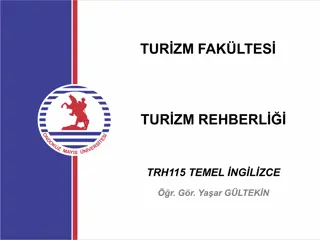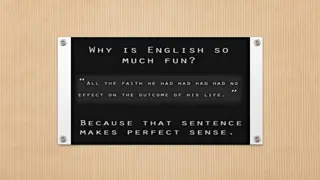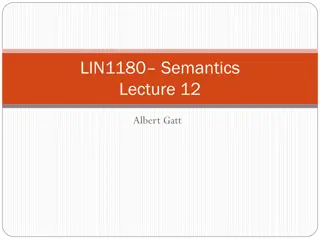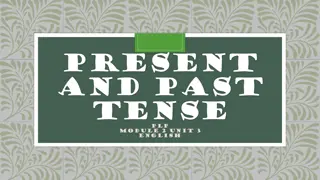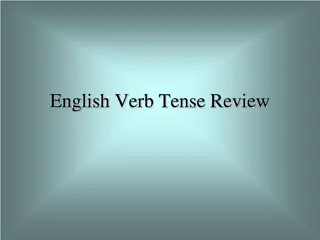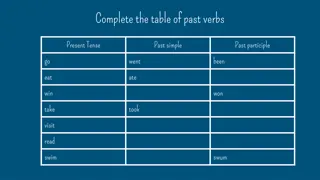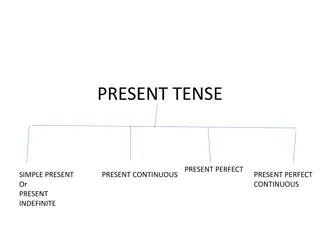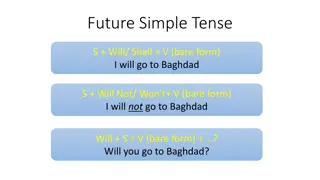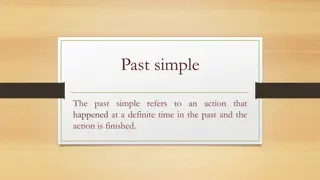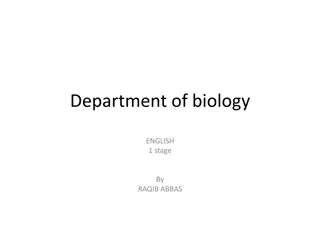Understanding Simple Past Tense in English: Rules and Examples
The simple past tense is a fundamental form in Modern English used to describe past events. It involves regular verbs adding "-ed" and irregular verbs having different forms. The construction of the simple past helps distinguish it from other past tense forms like past perfect and past progressive. Various rules apply for forming the simple past, including adding "-ed" to regular verbs, changing "y" to "i," and doubling final consonants in certain cases. This tense is crucial for expressing actions that occurred in the past accurately.
Download Presentation

Please find below an Image/Link to download the presentation.
The content on the website is provided AS IS for your information and personal use only. It may not be sold, licensed, or shared on other websites without obtaining consent from the author. Download presentation by click this link. If you encounter any issues during the download, it is possible that the publisher has removed the file from their server.
E N D
Presentation Transcript
TURZM FAKLTES TUR ZM REHBERL TRH115 TEMEL NG L ZCE r. G r. Ya ar G LTEK N
Simple Past The simple past, past simple or past indefinite, is the basic form of the past tense in Modern English. It is used principally to describe events in the past, although it also has some other uses. Regular English verbs form the simple past in -ed; however, there are a few hundred irregular verbs with different forms. The construction whose basic form uses the plain past tense alone, from other past tense constructions which use auxiliaries in combination with participles, such as the past perfect and past progressive. term "simple" is used to distinguish the syntactical
Simple Past Regular verbs form the simple past end-ed; however there are a few hundred irregular verbs with different forms. Most verbs have a single form of the simple past, independent of the person or number of the subject (there is no addition of -s for the third person singular as in the simple present). However, the copula verb be has two past tense forms: was for the first and third persons singular, and were in other instances.
Simple Past The past tense may be formed regularly or irregularly. With regular verbs, the past tense is formed (in terms of spelling) by adding -ed to the base form (play played). Normal rules for adding suffixes beginning with a vowel apply: If the base form ends in e then only d is added (like liked); if the base form ends in a consonant followed by y then the y is changed to i before adding the ending (try tried; an exception is the verb sky (a ball), which can form skied or skyed).
Simple Past Various rules apply for doubling final consonants. If the base form ends in a single vowel followed by a single consonant (except h, silent t, w, x or y), then unless the final syllable is completely unstressed the consonant is doubled before adding the -ed (ship shipped, but fathom fathomed). For most base forms ending in c, the doubled form used is ck, used regardless of stress (panic panicked; exceptions include zinc zincked or zinced, arc usually arced, spec specced or spec'ed, sync sometimes synched). In British English, the doubling of l occurs regardless of stress (travel travelled; but paralleled is an exception), and when two separately pronounced vowels precede the l (dial dialled, fuel fuelled).
Silent T fasten Fasten your shoe lace before you trip over. hasten Jim turned up the oven heat to hasten the cooking. glisten Frost can glisten in the sunlight. listen Make sure you listen out for my call. moistenMoisten the cloth then clean the keyboard. apostle Mark was an apostle of Christ. thistle Thistle plants were growing among the corn. whistle The referee blew his whistle at the end of the game. wrestle We saw the policeman wrestle the burglar to the ground. mortgage We'll need a bigger mortgage to buy a bigger house. Christmas Christmas is celebrated on the 25th of December.
Simple Past If the final syllable has some partial stress, especially for compound words, the consonant is usually doubled: backflip backflipped, hobnob hobnobbed, kidnap kidnapped etc. In some cases both alternatives are acceptable, e.g. dialog dialogued or dialogged , hiccup hiccupped or hiccuped, program programed or programmed. Note however catalog cataloged , pyramid pyramided, format formatted (but combat combat(t)ed). Other variations not entirely consistent with these rules include bus bused or bussed, bias biased or biassed and focus focused or focussed. (The forms marked are not used in British English, and the doubled consonant is not used for many words of non-Anglo-Saxon origin.)
Simple Past The pronunciation of the past tense ending follows similar rules to those for the third person present tense ending described above: if the base form ends in /t/ or /d/ then a new syllable / d/ or / d/ is added (as in drifted, exceeded); if the base form ends in an unvoiced consonant sound other than /t/ then the ending is pronounced /t/ (as in capped, passed); otherwise the ending is pronounced /d/ (as in buzzed, tangoed). Consequently, in the 17th and 18th centuries, the latter two pronunciations were routinely spelled -'d, but -ed was later restored.
Simple Past For the past tense of irregular verbs. Some of these can be classed as Germanic strong verbs, such as sing (past sang), while others are weak verbs with irregularly pronounced or irregularly spelt past forms, such as say (past tense said /s d/). The verb be has two past tense forms: was (first and third person singular) and were (plural and second person).
English Irregular Verbs The English language has many irregular verbs, approaching 200 in normal use and significantly more if prefixed forms are counted. Irregular verbs in Modern English are typically derived from verbs that followed more regular patterns at a previous stage in the history of the language. In particular, many such verbs derive from Germanic strong verbs, which make many of their inflected forms through vowel gradation, as can be observed in Modern English patterns such as sing sang sung.
English Irregular Verbs Most English irregular verbs are native, derived from verbs that existed in Old English. Nearly all verbs that have been borrowed into the language at a later stage have defaulted to the regular conjugation. There are a few exceptions, however, such as the verb catch (derived from Old Northern French cachier), whose irregular forms originated by way of analogy with native verbs such as teach.
English Irregular Verbs Most irregular verbs exist as remnants of historical conjugation systems. When some grammatical rule became changed or disused, some verbs kept to the old pattern. For example, before the Great Vowel Shift, the verb keep (then pronounced /ke p/, slightly like "cap" or "cape") belonged to a group of verbs whose vowel was shortened in the past tense; this pattern is preserved in the modern past tense kept (similarly crept, wept, leapt, left). Verbs such as peep, which have similar form but arose after the Vowel Shift, take the regular -ed ending..
English Irregular Verbs The force of analogy tends to reduce the number of irregular verbs over time, as irregular verbs switch to regular conjugation patterns (for instance, the verb chide once had the irregular past tense chid, but this has given way to the regular formation chided). This is more likely to occur with less common verbs (where the irregular forms are less familiar); hence it is often the more common verbs (such as be, have, take) that tend to remain irregular. Many irregular verbs today have coexisting irregular and regular forms (as with spelt and spelled, dreamt and dreamed, etc.).
English Irregular Verbs The verb forms described in this article are chiefly those that are accepted in standard English; many regional dialects have different irregular forms, such as American English sneak snuck and dive-dove as opposed to standard sneaked and dived respectively. In particular, it is fairly common in some types of non- standard speech to use (standard) past tenses as past participles, and vice versa; e.g "have went" instead of "have gone" in Southern American English.
English Irregular Verbs In the Germanic languages, a strong verb is a verb that marks its past tense by means of changes to the stem vowel (ablaut). The majority of the remaining verbs form the past tense by means of a dental suffix (e.g. -ed in English), and are known as weak verbs. In modern English, strong verbs include sing (present I sing, past I sang, past participle I have sung) and drive (present I drive, past I drove, past participle I have driven), as opposed to weak verbs such as open (present I open, past I opened, past participle I have opened). Not all verbs with a change in the stem vowel are strong verbs, however; they may also be irregular weak verbs such as bring, brought, brought or keep, kept, kept.
English Irregular Verbs The "strong" vs. "weak" terminology was coined by the German philologist Jacob Grimm in the 1800s, and the terms "strong verb" and "weak verb" are direct translations of the original German terms "starkes Verb" and "schwaches Verb".
Great Vowel Shift The Great Vowel Shift was a series of changes in the pronunciation of the English language that took place primarily between 1400 and 1700, beginning in southern England and today having influenced effectively all dialects of English. Through this vowel shift, the pronunciation of all Middle English long vowels was changed. Some consonant sounds changed as well, particularly those that became silent; the term Great Vowel Shift is sometimes used to include these consonant changes. English spelling began to become standardised in the 15th and 16th centuries, and the Great Vowel Shift is the major reason English spellings now often deviate considerably from how they represent pronunciations.
Great Vowel Shift The causes of the Great Vowel Shift have been a source of intense scholarly debate, and, as yet, there is no firm consensus. The greatest changes occurred during the 15th and 16th centuries. Population migration: Some scholars have argued that the rapid migration of peoples from northern England to the southeast following the Black Death caused a mixing of accents that forced a change in the standard London vernacular. French loan words: Others argue that the influx of French loanwords was a major factor in the shift.
Great Vowel Shift Middle class hypercorrection: Yet others assert that because of the increasing prestige of French pronunciations among the middle classes (perhaps related to the English aristocracy's switching from French to English around this time), a process of hypercorrection may have started a shift that unintentionally resulted in vowel pronunciations that are inaccurate imitations of French pronunciations. War with France: An opposing theory states that the wars with France and general anti-French hypercorrection deliberately to make English sound less like French sentiments caused
Great Vowel Shift Vowel pronunciation Word Late Middle English before the GVS Modern English after the GVS bite meet meat mate out boot boat /i / /e / / / /a / /u / /o / / / /a / /i / /e / /a / /u / /o /
Simple Past Basic simple past: I/you/he/she/it/we/they Expanded (emphatic) simple past: I/you/he/she/it/we/they did . Question form: Did I/you/he/she/it/we/they . Negative: I/you/he/she/it/we/they did not (didn't) .. Negative question: Did I/you/he/she/it/we/they not ..? / Didn't I/you/he/she/it/we/they .. ?
Usage Finished actions, states or habits in the past. 1: We use it with finished actions, states or habits in the past when we have a finished time word (yesterday, last week, at 2 o'clock, in 2003). I went to the cinema yesterday. We spent a lot of time in Japan in 2007. 2: We use it with finished actions, states or habits in the past when we know from general knowledge that the time period has finished. This includes when the person we are talking about is dead. Leonardo painted the Mona Lisa. The Vikings invaded Britain.
Usage 3: We use it with finished actions, states or habits in the past that we have introduced with the present perfect or another tense. This is sometimes called 'details of news'. I've hurt my leg. I fell off a ladder when I was painting my bedroom. I've been on holiday. I went to Spain and Portugal. 4: For stories or lists of events, we often use the past simple for the actions in the story and the past continuous for the background. He went to a caf . People were chatting and music was playing. He sat down and ordered a coffee.
Usage Unreal or imaginary things in the present or future. 5: We use the past simple to talk about things that are not real in the present or future. So we use it with the second conditional and after words like 'wish'. If I won the lottery, I would buy a house. I wish I had more time!
Past Continuous Tense The past continuous tense, also known as the past progressive tense, refers to a continuing action or state that was happening at some point in the past. The past continuous tense is formed by combining the past tense of to be (i.e., was/were) with the verb s present participle (-ing word).
Past Continuous Tense USE 1 InterruptedAction in the Past Use the past continuous to indicate that a longer action in the past was interrupted. The interruption is usually a shorter action in the simple past. Remember this can be a real interruption or just an interruption in time. Examples: I was watching TV when she called. When the phone rang, she was writing a letter. While we were having the picnic, it started to rain. What were you doing when the earthquake started? I was listening to my iPod, so I didn't hear the fire alarm.
Past Continuous Tense USE 2 Specific Time as an Interruption In USE 1, described above, the past continuous is interrupted by a shorter action in the simple past. However, you can also use a specific time as an interruption. Examples: Last night at 6 PM, I was eating dinner. At midnight, we were still driving through the desert. Yesterday at this time, I was sitting at my desk at work.
Past Continuous Tense USE 3 Parallel Actions When you use the past continuous with two actions in the same sentence, it expresses the idea that both actions were happening at the same time. The actions are parallel. Examples: I was studying while he was making dinner. While Ellen was reading, Tim was watching television. Were you listening while he was talking?
Past Continuous Tense USE 4 Atmosphere In English, we often use a series of parallel actions to describe the atmosphere at a particular time in the past. Example: When I walked into the office, several people were busily typing, some were talking on the phones, the boss was yelling directions, and customers were waiting to be helped
Past Continuous Tense USE 5 Repetition and Irritation with "Always" The past continuous with words such as "always" or "constantly" expresses the idea that something irritating or shocking often happened in the past. The concept is very similar to the expression used to but with negative emotion. Remember to put the words "always" or "constantly" between "be" and "verb+ing." Examples: She was always coming to class late. He was constantly talking. He annoyed everyone.
Past Continuous Tense While vs. When Clauses are groups of words which have meaning, but are often not complete sentences. Some clauses begin with the word "when" such as "when she called" or "when it bit me." Other clauses begin with "while" such as "while she was sleeping" and "while he was surfing." When you talk about things in the past, "when" is most often followed by the verb tense simple past, whereas "while" is usually followed by past continuous.
Simple Past https://www.spellzone.com/word_lists/list-775289.htm https://en.wikipedia.org/wiki/English_verbs#Past_tense https://en.wikipedia.org/wiki/Germanic_strong_verb https://en.wikipedia.org/wiki/Great_Vowel_Shift https://www.perfect-english-grammar.com/past-simple-use.html https://www.grammarly.com/blog/past-continuous- tense/#:~:text=The%20past%20continuous%20tense%2C%20also,prese nt%20participle%20(%2Ding%20word). https://www.englishpage.com/verbpage/types.html https://www.englishpage.com/verbpage/pastcontinuous.html





